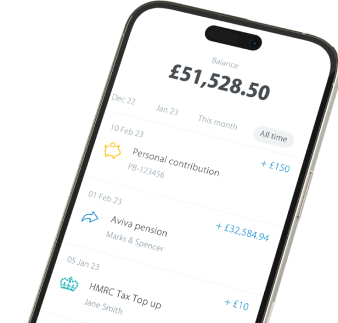
This article was last updated on 27/01/2025
Being your own boss comes with many perks: flexible hours, freedom to choose who you work with, and a chance to follow your passion. However, there are lots of things to consider when it comes to being your own boss and there’s one aspect where payrolled employees are outperforming their self-employed counterparts: pension wealth. Many self-employed savers aren’t prioritising their pension and risk running out of income in retirement. In fact, only 16% of self-employed people are even saving into their pension to begin with.
Why aren’t self-employed people saving more?
For the 4.4 million of the workforce who are self-employed being their own boss also means that they’re responsible for sorting their own retirement savings as they don’t benefit from Auto-Enrolment. It’s understandable that some business owners become overwhelmed with all the decisions they must make at the same time as the day-to-day running of their business, especially as often they don’t have a human resources department to turn to.
What options do self-employed savers have?
With 16% of the UK population being self-employed the pension savings of this group aren’t keeping pace with the rising cost of living. So how can the self-employed better prepare for a happy retirement? Everyone has different dreams for their golden years - whether that’s retiring to Spain, gardening at home or starting their own business in retirement. At the core retirees want financial freedom and to achieve that, you must start by taking control of your pension today.
Here’s a breakdown of your retirement income options as a self-employed person:
Entitlement to State Pension
How do you get a State Pension? Well, when you pay National Insurance you’ll accrue State Pension benefits. To get the full new State Pension you’ll need 35 qualifying years of contributions. If you’re a few years off, you can make voluntary contributions to top it up. However, even the full new State Pension is only £221.20 per week.
Previous workplace pension pots
Employers now automatically enrol most employees into a workplace pension. If you earned more than £10,000 a year and were over 22 years old, you’ll probably have saved into one. Lost track of where your old pensions are? You can try the free government Pension Tracing Service to find information about your previous employer’s pension schemes.
Starting a self-employed pension
If you work for yourself, setting up a pension and ensuring you save enough for retirement is your responsibility. Most people usually receive tax relief from the government with a self-employed pension, but won’t benefit from employer contributions. But if you’re the director of a limited company, company contributions may be considered an allowable business expense and could be offset against your company’s corporation tax.
Like being in control of your pension? A Self-Invested Personal Pension (SIPP) is a pension plan that lets you choose how your savings are invested. Building a pension pot may seem tricky if you don’t receive a regular income. At PensionBee we allow flexible payments, so you can contribute what you can afford, when you can afford it. Our self-employed pension allows you to make both employer and employee contributions from our app.
Benefits of having a self-employed pension
1. Pick the plan that’s right for you
Self-employment gives you more choice, such as what pension plan you’ll save into. Choosing a pension involves comparing scheme details like annual fees and risk level. You may place the long-term impact of your investment as a priority, for instance choosing a plan that’s Shariah-compliant or a sustainable plan such as our Climate Plan.
If you’re looking for a private pension to make self-employed contributions into, you may want to consider the benefits of accessible and transparent technology. Open Banking is a technology that allows customers to share their data securely between financial institutions. This makes payment initiation easier and quicker than manually entering your details.
2. Combine pots to accelerate compounding
To consolidate your pensions into one single plan, you will need to provide information about your pensions to your new provider. The average person works 11 jobs by the time they retire. Transferring any old pensions into your new one can make your savings easier to manage and you’ll only have one fee to pay.
Another advantage of having one pension pot is compounding. The interest on your savings is reinvested which means your interest gains interest - this is the power of compound growth. Through compounding over the long-term even small pensions can see significant growth.
3. Make flexible contributions
One of the best things about setting up a self-employed pension is that you’ll usually be eligible to receive tax relief on your contributions from the government. Most UK taxpayers usually get tax relief on their personal pension contributions, which means that the government effectively adds money to your pension pot. Most basic rate taxpayers usually get a 25% tax top up; HMRC adds £25 for every £100 you pay into your pension making it £125.
If you pay a higher rate of tax, you’ll be able to reclaim additional tax relief through your tax return. When you’re making decisions about your finances - don’t pay yourself less, pay yourself first. Paying into a self-employed pension plan may help you enjoy a comfortable retirement or even afford to retire early.
PensionBee’s flexible self-employed pension
Our flexible pension for self-employed customers means they can start a new pension with no minimum contributions. We understand that month to month your income can vary when you’re self-employed so we wanted a product that allows the same level of flexibility.
Romi Savova, CEO of PensionBee commented: Without the benefits of Auto-Enrolment, the self-employed are at a significant disadvantage and need access to simple and flexible products urgently if they are to avoid a shortfall in later life. The self-employed currently make up 20% of the PensionBee customer base, so we know their needs well and are committed to helping many more self-employed consumers plan for a happy retirement and achieve better financial outcomes.
It takes just a few minutes to sign up to PensionBee’s self-employed pension, which is available exclusively to sole traders and directors of limited companies without an existing workplace or private pension to consolidate. Why not listen to the keeping your self-employed pension on track episode of our Pension Confident Podcast to hear from the experts themselves? If you’re thinking about venturing into self-employment you may want to listen to our podcast episode on How to start a business.
Risk warning
As always with investments, your capital is at risk. The value of your investment can go down as well as up, and you may get back less than you invest. This information should not be regarded as financial advice.






